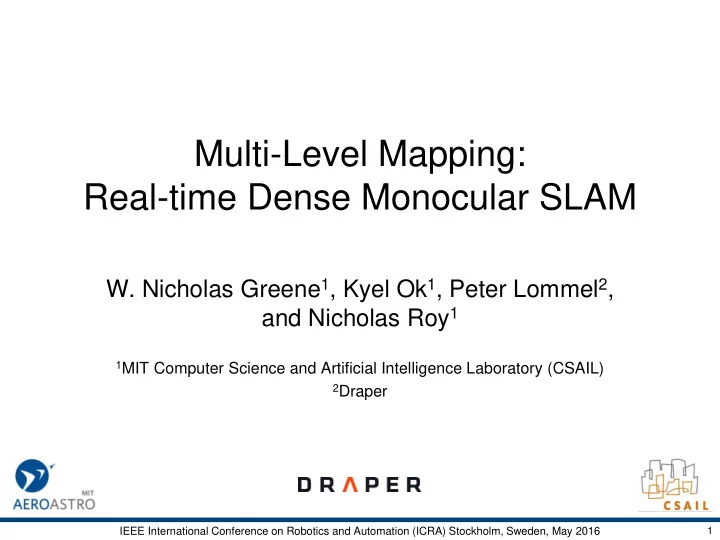

Multi-Level Mapping: Real-time Dense Monocular SLAM W. Nicholas Greene 1 , Kyel Ok 1 , Peter Lommel 2 , and Nicholas Roy 1 1 MIT Computer Science and Artificial Intelligence Laboratory (CSAIL) 2 Draper IEEE International Conference on Robotics and Automation (ICRA) Stockholm, Sweden, May 2016 1
Monocular SLAM Simultaneous Localization and Mapping We want to estimate dense 3D maps online using low-SWaP cameras to enable high- speed autonomous navigation, but… Multi-Level Mapping: Real-time Dense Monocular SLAM 2 W. Nicholas Greene
Prior Work: Sparse Methods Use features (FAST, SIFT, etc.) extracted from images to estimate sparse point cloud MonoSLAM (Davison, ICCV 2003, 2007), PTAM (Klein and Murray, ISMAR 2007) Sparse maps are cheap, but problematic for motion planning Multi-Level Mapping: Real-time Dense Monocular SLAM 3 W. Nicholas Greene
Prior Work: Dense Methods Use raw pixel intensities and GPU acceleration to estimate dense mesh. DTAM (Newcombe et al., ICCV 2011), MonoFusion (ISMAR 2013) Dense maps are accurate, but expensive to compute and small-scale 4 W. Nicholas Greene Multi-Level Mapping: Real-time Dense Monocular SLAM
Prior Work: Semi-dense Methods Use only pixels with gradient to estimate semi-dense point cloud LSD-SLAM (Engel et al. ICCV 2013, ECCV 2014) Noise Holes Semi-dense maps have holes in low-texture regions Multi-Level Mapping: Real-time Dense Monocular SLAM 5 W. Nicholas Greene
Prior Work: Semi-dense Methods Use only pixels with gradient to estimate semi-dense point cloud LSD-SLAM (Engel et al. ICCV 2013, ECCV 2014) Noise Holes Can we estimate dense geometry without sacrificing speed? Multi-Level Mapping: Real-time Dense Monocular SLAM 6 W. Nicholas Greene
Multi-Level Mapping (MLM) Key Insights Low-texture regions correlated with planar structure - don’t need to 1. reason about every pixel to reconstruct scene, but don’t need to completely discard data. 2. World is locally smooth . Approach 1. Estimate depth at image scale appropriate to texture More gradient → finer resolution - Less gradient → coarser resolution - 2. Apply smarter spatial regularization to multi-level map Estimate depth on a quadtree to leverage all available texture and smooth using a variational regularizer Multi-Level Mapping: Real-time Dense Monocular SLAM 7 W. Nicholas Greene
Example Keyframe: MLM Epipolar search region Keyframe Comparison image MLM estimates depth at quadtree leaves at corresponding image scale Multi-Level Mapping: Real-time Dense Monocular SLAM 8 W. Nicholas Greene
Smoothing The keyframe inverse depthmap is likely corrupted by noise and outliers. Before finalizing keyframe, apply variational smoothing technique from Chambolle and Pock 2011. Let denote the smoothed inverse depthmap. We perform the following optimization: Quadtree data structure allows fast optimization without GPU acceleration Multi-Level Mapping: Real-time Dense Monocular SLAM 9 W. Nicholas Greene
Qualitative Evaluation Kinect LSD-SLAM MLM Multi-Level Mapping: Real-time Dense Monocular SLAM 10 W. Nicholas Greene
11 W. Nicholas Greene
Thank You! Multi-Level Mapping: Real-time Dense Monocular SLAM 12 W. Nicholas Greene
Recommend
More recommend